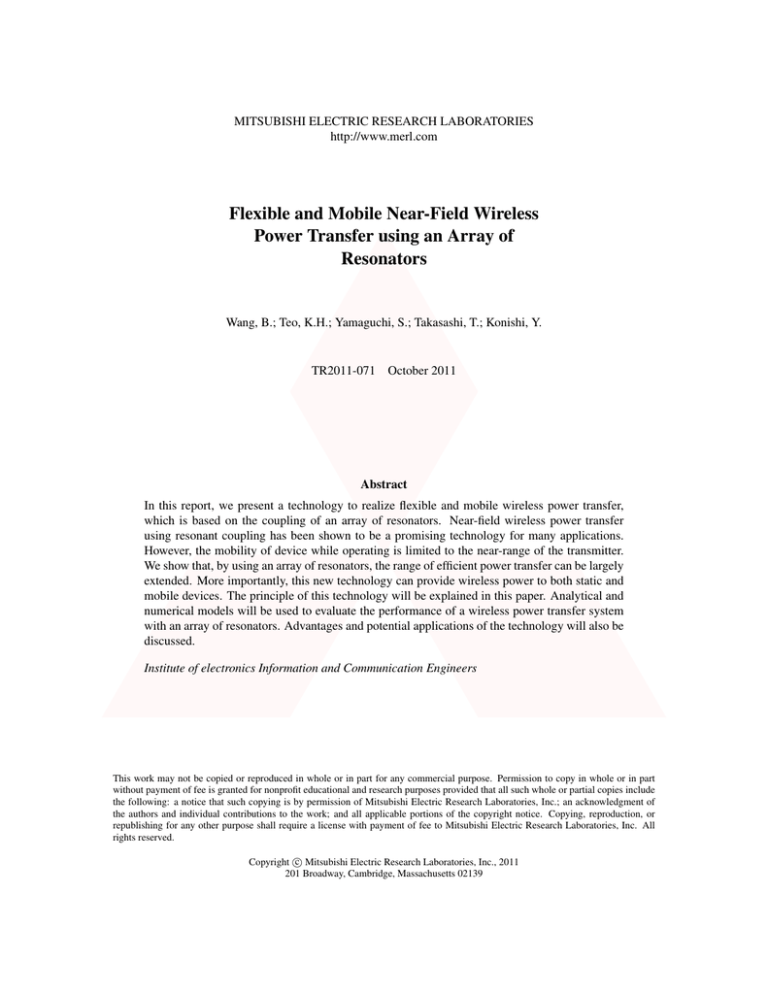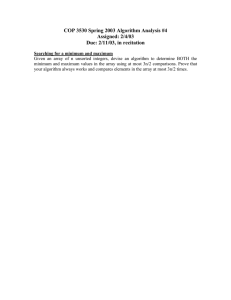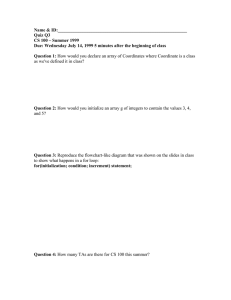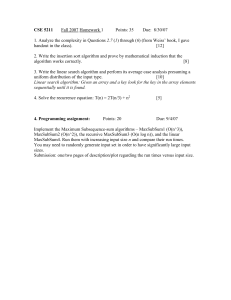
MITSUBISHI ELECTRIC RESEARCH LABORATORIES
http://www.merl.com
Flexible and Mobile Near-Field Wireless
Power Transfer using an Array of
Resonators
Wang, B.; Teo, K.H.; Yamaguchi, S.; Takasashi, T.; Konishi, Y.
TR2011-071
October 2011
Abstract
In this report, we present a technology to realize flexible and mobile wireless power transfer,
which is based on the coupling of an array of resonators. Near-field wireless power transfer
using resonant coupling has been shown to be a promising technology for many applications.
However, the mobility of device while operating is limited to the near-range of the transmitter.
We show that, by using an array of resonators, the range of efficient power transfer can be largely
extended. More importantly, this new technology can provide wireless power to both static and
mobile devices. The principle of this technology will be explained in this paper. Analytical and
numerical models will be used to evaluate the performance of a wireless power transfer system
with an array of resonators. Advantages and potential applications of the technology will also be
discussed.
Institute of electronics Information and Communication Engineers
This work may not be copied or reproduced in whole or in part for any commercial purpose. Permission to copy in whole or in part
without payment of fee is granted for nonprofit educational and research purposes provided that all such whole or partial copies include
the following: a notice that such copying is by permission of Mitsubishi Electric Research Laboratories, Inc.; an acknowledgment of
the authors and individual contributions to the work; and all applicable portions of the copyright notice. Copying, reproduction, or
republishing for any other purpose shall require a license with payment of fee to Mitsubishi Electric Research Laboratories, Inc. All
rights reserved.
c Mitsubishi Electric Research Laboratories, Inc., 2011
Copyright 201 Broadway, Cambridge, Massachusetts 02139
MERLCoverPageSide2
␠࿅ᴺੱ 㔚ሶᖱႎㅢାቇળ
THE INSTITUTE OF ELECTRONICS, INFORMATION AND COMMUNICATION ENGINEERS
ାቇᛛႎ
IEICE Technical Report
Flexible and Mobile Near-Field Wireless Power Transfer using an Array of
Resonators
Bingnan WANG† Koon Hoo TEO† Satoshi YAMAGUCHI‡ Toru TAKAHASHI‡ Yoshihiko KONISHI‡
̐Mitsubishi Electric Research Labs, 201 Broadway, Cambridge, MA 02139 USA
‡ Mitsubishi Electric Corporation, 5-1-1 Ofuna, Kamakura, Kanagawa, 247-8501 Japan
E-mail: †{bwang, teo}@merl.com, ‡{Yamaguchi.Satoshi@ce, Takahashi.Toru@dx,
Konishi.Yoshihiko@dh}.MitsubishiElectric.co.jp
Abstract In this report, we present a technology to realize flexible and mobile wireless power transfer,
which is based on the coupling of an array of resonators. Near-field wireless power transfer using resonant
coupling has been shown to be a promising technology for many applications. However, the mobility of
device while operating is limited to the near-range of the transmitter. We show that, by using an array of
resonators, the range of efficient power transfer can be largely extended. More importantly, this new
technology can provide wireless power to both static and mobile devices. The principle of this technology
will be explained in this paper. Analytical and numerical models will be used to evaluate the performance of
a wireless power transfer system with an array of resonators. Advantages and potential applications of the
technology will also be discussed.
Keyword Wireless power transfer, Resonant coupling, array of resonators
1. Introduction
In recent years, the demand of wireless power
transfer (WPT) technologies is rapidly increasing,
largely due to the emerging needs of wireless
charging for electronic devices and electric vehicles.
Different technologies are under development by
physicists and engineers worldwide. Microwave
power transmission is targeted for long distance and
large scale power transmission ( for example, see Ref.
[1]). For short-distance applications, where the
power transfer distance lies between a few
centimeters to a few meters, inductive coupling
method has long been pursued (for example, see Ref.
[2-3]). Power from a few milliwatts to a few
kilowatts can be efficiently transferred with
inductive coupling. However the transfer distance is
limited to a few centimeters.
Following the renowned experiment of an MIT group
in 2007 [4], resonant coupling method has attracted a
lot attention for short-distance WPT (see Ref. [5-7]).
Compared with inductive coupling, resonant
coupling method is more flexible with device
misalignment, and more importantly, can achieve
longer transfer distance. In the MIT experiment, 40%
efficiency is achieved at a dist ance of 2 m. This is a
big advantage compared with inductive coupling.
However, the efficiency will drop when the distance
increases and the resonators are under coupled [4, 7].
Recently, metamaterials have been applied to
resonant coupling system for coup ling enhancement
and efficiency improvement [8 -11]. Experiment
result shows that the power transfer efficiency can
be greatly improved by a metamaterial slab [11].
With this technology the power transfer range and
efficiency can be further improved.
The above technologies are mainly for static power
transfer, where the receiving device is not moving
and placed in the close range of transmitter. The
mobility of receiving device is very limited. These
technologies are not suitable for power transfer to
mobile devices and equipment, such as moving
electric cars and trains. For these applications, a
mobile power transfer technology needs to be
developed. Mobile power transfer is much more
complicated than static power transfer, and is a more
challenging task to deal with.
In this report, we propose the use of array of
resonators for mobile power transfer. We will show
that by using this technology, the effective power
transfer range can be greatly extended; more
importantly, power can be delivered to multiple
moving devices. This technology has great potential
in applications such as wireless powered road/lane
for electric vehicles, wireless power solution for
Copyright ©20٨٨ by IEICE
roaming robots, etc.
2. Concept of array of resonators for WPT
In a WPT system based on resonant couplin g, the
essential parts are two resonators tuned to the same
resonator frequency, one serves as transmitter and
the other serves as receiver. In addition,
high-frequency power can be coupled from source to
resonator in different approaches. In Fig. 1(a), lo op
antennas are used to inductively couple power from
source to resonator and from resonator to
power-consuming device. To achieve efficient power
transfer, the receiver needs to be in close range of
the transmitter. The system is not suitable for
transmitting power to a moving device with traveling
distance much larger than the size of resonator.
As shown in Fig. 1(b), an array of resonators is
formed by putting resonators of the same or similar
resonant frequency in close range. When one of the
resonators in the array is excited by an external
source, power can be transferred to neighboring
resonators via resonant coupling, in a similar
procedure as one-to-one WPT shown in Fig. 1(a).
Through resonant coupling, power can be transferred
to all other resonators in the array. In this sense, the
array serves as effectively a waveguide for the
near-field surface waves formed on the resonators.
When a power-consuming device with a resonator as
receiver is in the close range of the array, power can
be transferred from the array to the receiver, again
through resonant coupling. The receiver can be
anywhere along the array. This way the effective
power transfer range is greatly extended. More
importantly, the receiver can be used for traveling
devices, as long as the devices are in close range of
the array. Plus, the array system is capable of
providing power to more than one device at the same
time.
(a) WPT system with one resonator as transmitter
and one resonator as receiver.
(b) WPT system with an array of resonators as
transmitter and one resonator as receiver.
Fig. 1 Illustration of WPT systems.
It is worth to mention that the array can be very
flexible and form in different shapes. As a few
examples, Fig. 2 shows some of the forms array can
take. Depending on the requirements, an array can be
formed in a straight line (Fig. 1(b)), a bended line
(Fig. 2(a)), a closed loop (Fig. 2(b)), or even a 2d
surface (Fig. 2(c)). With this powerful tool, WPT can
be used for many potential applications with moving
or static devices.
(a) Array of resonator in a bended line.
(b) Array of resonators in a closed loop.
Fig. 3 Geometry of three test examples.
(c) Array of resonators in 2d surface.
Fig. 2 Examples of arrays in different forms .
3. Simplified analytical model
In order to study the performance of a WPT system
with array of resonators, a simplified model is used
to quickly analyze the power transfer behavior.
In the simplified model, each resonator is modeled
as a current-carrying loop, whose inductance can be
calculated using
L
0
R ln
8R
a
2
Where R is the radius of the loop and a is the radius
of wire. A lumped capacitor C is added to the loop in
order to give the loop a resonant frequency. The
coupling between resonators is modeled by the
mutual inductance. For a general case, consider two
loops with parameters and relative positions given in
Fig. 3 , the mutual inductance M of them can be
given by the following equation.
Fig. 4 Equivalent circuits for transmitting antenna,
resonant loops and receiving antenna .
For a system with n resonators in the array, and one
resonator as receiver, the system can be described by
Kirchhoff ’s law.
V0
0
0
M
0
0
0
Z0
j M 01
0
M
0
0
0
j M 01
Z1
j M 12
M
j M 1n
j M 1r
0
0
j M 12
Z2
M
j M 2n
j M 2r
0
L
L
L
O
L
L
L
0
j M 1n
j M 2n
M
Zn
j M nr
0
0
j M 1r
j M 2r
M
j M nr
Zr
j M rd
0
0
0
M
0
j M rd
Zd
I0
I1
I2
M
In
Ir
Id
In the above equation, the subscript 0 means the
transmitting antenna, subscript d means the receiving
antenna
with
load,
2
2
(sin 1 si
sin 2 co
cos 1 co
cos 2 co
coss )
0
subscript
r
means
the
M
R1 R2
d 1d 2
0
0
4
( R1 cos 1 R2 cos 2 ) 2 (R
( R1 sin 1 t R2 sin 2 co
coss ) 2 (d R2 sin 2 sin
si ) 2
receiving resonator and
After the calculation, each resonator is modeled as
subscript i means the i-th resonator in the array. Z
an RLC circuit, as shown in Fig. 4. The equivalent
terms are the impedances of circuits and M terms are
impedance of i-th loop in the array is modeled as
mutual coupling terms of corresponding circ uits
1
denoted by the subscript. Note that only the nearest
Z i Ri j Li
j Ci
two neighbors on each side of a resonator in the
array are considered for simplification. The current
on the load, and hence the power transfer efficiency
can be obtained by solving the equation.
As an example, we consider an array of 10 reson ant
loops in a straight line. A loop antenna is used to
excite the first loop, and a receiving resonant loop is
at a distance of 0.5R above the array on top of the
last loop in the array. The resonant frequency of the
loops is 25 MHz. Using the model descr ibed above,
the power transfer efficiency of the system is
calculated as a function of excitation frequency and
plotted in Fig. 5. High efficiency (about 90%) is
achieved around the resonant frequency. The
multiple peaks are due to the mutual coupling
between resonators in the array.
When there is no receiver nearby, power oscillates
the array without radiation to far-field. When
receiver is put close to the array, power
transferred to it via resonant coupling, as shown
Fig. 6(b).
in
a
is
in
(a) Field distribution without receiver
Fig. 5 Calculated power transfer efficiency of a system
with an array of 10 resonators.
4. Numerical Simulations
In this section, numerical simulations are performed
to further study the properties of WPT system with
array of resonators. The simulations are done in
commercially available package COMSOL.
First, a coil resonator is designed with resonant
frequency around 25 MHz. The coil is in square
shape with side length of 20 cm and 6 turns of wire.
10 such coils are used to form an array in straight
line. A loop antenna is used to provide power to the
array by inductive coupling. Fig. 6 plots the field
distribution when the system is resonance, which
helps to understand the physical principle of the
system. As shown in Fig. 6(a), when the loop
antenna is coupled the first coil in the array, strong
field is seen along all coils in the array, which
indicates the resonant coupling behavior in the array.
(b) Field distribution with receiver
Fig. 6 Field distribution of a WPT system with an array
of resonators.
also drops due to weaker coupling. Different
approaches can be used to reduce this fluctuation
and improve the performance of the system. For
examples, improved array and receiver design can
help to achieve better coupling at all positions;
adaptively tuning the excitation frequency can
optimize the system efficiency through modifying
the field distribution pattern along the array. These
are beyond the scope of this report and will not be
discussed in details here.
5. Conclusions
Fig. 7 Simulated power transfer efficiency of the array
system as a function of receiver position.
The power transfer efficiency can also be simulated
with COMSOL. The simulated structures are shown
in Fig. 6. One loop antenna is used to provide power
inductively to the array. A second loop antenna is
coupled to a receiving resonator for power
consumption. The efficiency is calculated as the
ratio of power goes to the receiving loop antenna and
power transmitted from the first loop antenna. To
evaluate the performance of the system for a moving
device, the position of the receiver is scanned from
one end of the array to the other, and efficiency is
calculated for each case. Fig. 7 shows the simulated
power transfer efficiency of the described system as
a function of receiver position. The position is in
unit of unit cell size, which is the distance between
the centers of neighboring coils in the array. The
distance between receiving coil and the array is 10
cm. From the figure, we can see that very high
efficiency (85%) can be achieved with this system.
However, the efficiency is not constant when the
receiver is at different positions. This is due to the
resonant coupling nature of the system. As shown in
Fig. 6, the field at resonance forms a standing wave
pattern with nodes and antinodes, instead of evenly
distributed through the array. Thus when the receiver
is at different positions, different coupling is
expected between the array and the receiver, leading
to fluctuations in the power transfer efficiency. In
general, the fluctuation is related to the distance
between array and receiver. Less fluctuation is
expected with larger distance between array and
receiver; however, in this case, the overall efficiency
In summary, we have proposed the idea of using an
array of resonators for mobile power transfer. The
new technology is based on resonant coupling. An
array is formed by multiple resonators arranged in
close range, without electric connections in between.
We showed that by using this technology, the
effective power transfer range can be greatly
extended. Moreover, the technology has the
capability of delivering power to multiple moving
devices at the same time. Analytical and numerical
calculations both show that >85% efficiency can be
achieved with an array of 10 resonators long.
References
[1] N. Shimokura, N. Kaya, M. Shinohara, and H.
Matsumoto, Electrical Engineering in Japan 120
(1), 33-39 (1997)
[2] N. de N. Donaldson and T. A. Perlins, Med. &
Biol. Eng. & Comput., 21, 612 (1983)
[3] Z. N. Low, R. A. Chinga, R. Tseng and J. Lin,
IEEE Transactions on Industrial Electronics, 56,
1801 (2009)
[4] A. Kurs, A. Karalis, R. Moffatt, J. D.
Joannopoulos, P. Fisher and M. Soljiacic,
Science, 317, 83 (2007)
[5] B. L. Cannon, J. F. Hoburg, D. D. Stancil and S.
C. Goldstein, IEEE TRANSACTIONS ON
POWER ELECTRONICS, 24, 1819, (2009)
[6] Q. Yuan, Q. Chen, L. Li and K. Sawaya, IEEE
TRANSACTIONS ON ANTENNAS AND
PROPAGATION, 58, 1751, MAY 2010
[7] A. P. Sample, D. T. Meyer and Joshua R . Smith,
IEEE Transactions on Industrial Electronics, 58,
544 (2011)
[8] B.Wang, T. Nishino, and K. H. Teo, Wireless
Information Technology and Systems (ICWITS),
2010 IEEE International Conference (Aug. 28
2010-Sept. 3 2010, Honolulu, HI)
[9] B. Wang, K. H. Teo, T. Nishino, W. Yerazunis, J.
Barnwell and J. Zhang, European Conference on
Antennas and Propagation (EuCAP 2011) (April
11–15 2011, Rome, Italy)
[10]
Y. Urzhumov and D. R. Smith, Phys. Rev. B
83, 205114 (2011)
[11]
B. Wang, K. H. Teo, T. Nishino, W.
Yerazunis, J. Barnwell and J. Zhang, Appl. Phys.
Lett. 98, 254101 (2011)





